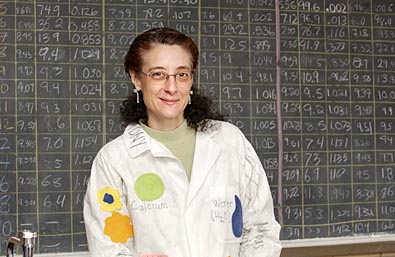Inside Iowa State
Inside ArchivesSubmit newsSend news for Inside to inside@iastate.edu, or call (515) 294-7065. See publication dates, deadlines. About InsideInside Iowa State, a newspaper for faculty and staff, is published by the Office of University Relations. |
February 25, 2005 You can't avoid it; microbiology affects everyoneby Samantha Beres Hidden in the corner of Joan Cunnick's office is a lab coat that is decorated with giant fabric cut-outs of microbes, molecules and immune cells. While she models it, she points out a lymphocyte and jokes, "Talk about a pocket protector." 
Microbiologist Joan Cunnick only wears her decorated lab coat for special occasions, such as when kids come to visit her lab. Photo by Bob Elbert. Associate professor of animal science and professor-in-charge of the undergraduate microbiology program, Cunnick only wears that lab coat on special occasions, for instance when third graders visit the lab. But her passion for microbiology is apparent in her teaching and research. A holistic approachFor more than 20 years, Cunnick's research has focused on things that elicit a response from the immune system. As a graduate student, she studied bitter mellon, an oriental vegetable with a 500-year history of medicinal uses. As a postdoc, she looked at immune suppression due to stress. Since being hired at Iowa State 13 years ago, she has collaborated with several departments. She's currently working with researchers in the Center for Research on Dietary Botanical Supplements to test whether Echinacea has immune-enhancing properties. When asked about her research that seemingly focuses on alternative medicine, she laughed and said she firmly believes in Western medicine. "Alternative medicine has to have a medical basis," she said. "We have to remember that the pharmaceutical industry grew out of bacteria and plants. When they were looking for cancer drugs, they were testing every plant out there." Her Echinacea experiments haven't shown a decrease in the viral load, but she asked, "What if that's not what we're supposed to look at? What if Echinacea improves healing and recovery from the virus?" She explained that healing is only part of the immune system function. Different cells within the system have different tasks. She uses the analogy of an elderly person recovering from the flu. Although the flu virus may be gone, the cells in the lungs may not heal as fast, making the person susceptible to other lung infections. This holistic view is how she approaches her work. "If you're going to look at the immune system, do you want to look at one cell and how it acts? Or do you want to look at how the cells act in the whole animal," she said. "It's sort of like I look at the immune system with the fur on." Everyone's a microbiologistCunnick's interest in microbiology can be traced to her childhood. She says she grew up with it. Both parents worked in the medical field and though her father is an osteopathic doctor, he taught medical micro-biology before opening a family medical practice. "I see that it's around us everywhere," Cunnick said. "I like to tell students that farmers who have been rotating crops here for over 100 years use microbiology whether they know it or not." Corn crops use nitrogen in the soil. Soybean crops put nitrogen back in. That gets Cunnick excited. "Everybody knows that. But it's not the soybean, it's the bacteria in the root nodules of the soybean that put the nitrogen back in the soil." Cutting-edge researchCunnick also collaborates with agronomy associate professor Kan Wang, who is working to genetically modify corn to vaccinate pigs against a virus. It's Cunnick's job to ensure the safety of that corn by testing how the immune systems of domestic animals will respond to it, in case the corn accidentally gets into other feed crops. "One of the things that people say to scientists is that they go down their merry path and don't think about repercussions of their research," Cunnick said. "And yet, GMOs in this country have lots of questions about safety concerns. So, we feel that we have to address it upfront, and better to address it now rather than later." Teacher and mentorFor the past year and a half, Cunnick has been professor-in-charge of the microbiology program. (Once a department, the faculty were reorganized into several departments. The microbiology program is managed by animal science and plant pathology.) She is also adviser to the undergraduate microbiology club. And, while her research is important, educating is a priority for her. "I want to encourage young scientists," she said. "And I enjoy the challenges of teaching at all levels, showing people that you can enjoy science and have it apply to your world." Perhaps past students can speak best to her teaching abilities. Some of her students (one an advisee) bought a brick in her honor at the Plaza of Heroines. They wrote: From what Dr. Cunnick gets as an ISU professor, she can make a living; what she has given, however, has fostered bountiful lives. To our teacher, adviser and mentor: Thank you. As an educator, she goes beyond the doors of Iowa State. She is a Girl Scout leader for her daughter's troop and past leader for her son's Cub Scout troop. And, she makes time to visit classrooms to make presentations on microbiology. On visits to elementary schools, she tells the students that everybody has a favorite microbe. "Mine happens to be those in yogurt," she said. "We talk about pizza and how you can use microbes in order to make the summer sausage or cheese. Yeast goes in the crust. So we're all microbiologists whether we know it or not. You can't avoid it." |
Quote"If you're going to look at the immune system, do you want to look at one cell and how it acts? Or do you want to look at how the cells act in the whole animal. It's sort of like I look at the immune system with the fur on." Joan Cunnick |